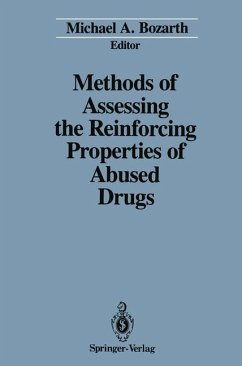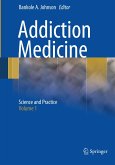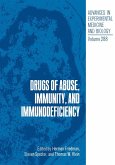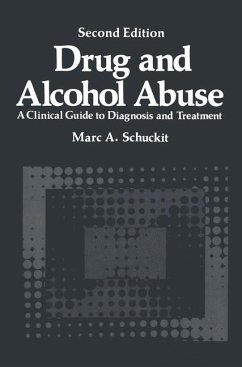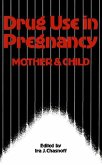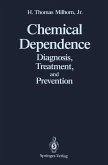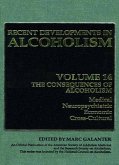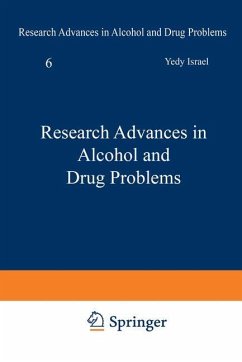Methods of Assessing the Reinforcing Properties of Abused Drugs
Herausgegeben von Bozarth, Michael A.
Methods of Assessing the Reinforcing Properties of Abused Drugs
Herausgegeben von Bozarth, Michael A.
- Broschiertes Buch
- Merkliste
- Auf die Merkliste
- Bewerten Bewerten
- Teilen
- Produkt teilen
- Produkterinnerung
- Produkterinnerung
Methods of Assessing the Reinforcing Properties of Abused Drugs presents a synopsis of the preclinical procedures used to assess drug reinforcement. Researchers using one technique are provided with an overview of the other available methods, and clinicians who wish to evaluate drug abuse research reports can gain the necessary background from this volume. Although emphasis is placed on the methodological aspects of assessing drug reinforcement, some of the scientific conclusions derived from using these techniques are also presented. This edited collection offers a lasting framework for interpreting the results of current experimental findings.…mehr
Andere Kunden interessierten sich auch für
![Addiction Medicine Addiction Medicine]() Addiction Medicine267,99 €
Addiction Medicine267,99 €![Drugs of Abuse, Immunity, and Immunodeficiency Drugs of Abuse, Immunity, and Immunodeficiency]() Drugs of Abuse, Immunity, and Immunodeficiency81,99 €
Drugs of Abuse, Immunity, and Immunodeficiency81,99 €![Drug and Alcohol Abuse Drug and Alcohol Abuse]() Marc A. SchuckitDrug and Alcohol Abuse41,99 €
Marc A. SchuckitDrug and Alcohol Abuse41,99 €![Drug Use in Pregnancy: Mother and Child Drug Use in Pregnancy: Mother and Child]() Drug Use in Pregnancy: Mother and Child41,99 €
Drug Use in Pregnancy: Mother and Child41,99 €![Chemical Dependence Chemical Dependence]() H. Thomas MilhornChemical Dependence41,99 €
H. Thomas MilhornChemical Dependence41,99 €![The Consequences of Alcoholism The Consequences of Alcoholism]() Recent Developments in AlcoholismThe Consequences of Alcoholism121,99 €
Recent Developments in AlcoholismThe Consequences of Alcoholism121,99 €![Research Advances in Alcohol and Drug Problems Research Advances in Alcohol and Drug Problems]() Yedy IsraelResearch Advances in Alcohol and Drug Problems41,99 €
Yedy IsraelResearch Advances in Alcohol and Drug Problems41,99 €-
-
-
Methods of Assessing the Reinforcing Properties of Abused Drugs presents a synopsis of the preclinical procedures used to assess drug reinforcement. Researchers using one technique are provided with an overview of the other available methods, and clinicians who wish to evaluate drug abuse research reports can gain the necessary background from this volume. Although emphasis is placed on the methodological aspects of assessing drug reinforcement, some of the scientific conclusions derived from using these techniques are also presented. This edited collection offers a lasting framework for interpreting the results of current experimental findings.
Produktdetails
- Produktdetails
- Verlag: Springer / Springer New York / Springer, Berlin
- Artikelnr. des Verlages: 978-1-4612-9163-3
- Softcover reprint of the original 1st ed. 1987
- Seitenzahl: 676
- Erscheinungstermin: 1. Juli 2012
- Englisch
- Abmessung: 235mm x 155mm x 37mm
- Gewicht: 1008g
- ISBN-13: 9781461291633
- ISBN-10: 1461291631
- Artikelnr.: 36120110
- Herstellerkennzeichnung Die Herstellerinformationen sind derzeit nicht verfügbar.
- Verlag: Springer / Springer New York / Springer, Berlin
- Artikelnr. des Verlages: 978-1-4612-9163-3
- Softcover reprint of the original 1st ed. 1987
- Seitenzahl: 676
- Erscheinungstermin: 1. Juli 2012
- Englisch
- Abmessung: 235mm x 155mm x 37mm
- Gewicht: 1008g
- ISBN-13: 9781461291633
- ISBN-10: 1461291631
- Artikelnr.: 36120110
- Herstellerkennzeichnung Die Herstellerinformationen sind derzeit nicht verfügbar.
Self-Administration Studies.- 1: Intravenous self-administration: Response rates, the effects of pharmacological challenges, and drug preferences.- 2: Screening for drug reinforcement using intravenous self-administration in the rat.- 3: Assessing drugs for abuse liability and dependence potential in laboratory primates.- 4: Interpretation of lesion effects on stimulant self-administration.- 5: Second-order schedules of drug injection.- 6: Intravenous drug self-administrations A special case of positive reinforcement.- 7: Oral drug self-administrations Drugs as reinforcers.- 8: Oral self-administration of alcohols A valid approach to the study of drug self-administration and human alcoholism.- 9: Intracranial self-administration procedures for the assessment of drug reinforcement.- 10: Prediction of drug abuse liability from animal studies.- Conditioning Studies.- 11: Conditioned reinforcement as a measure of the rewarding properties of drugs.- 12: Reinstatement of drug-taking behavior as a method of assessing incentive motivational properties of drugs.- 13: Place conditionings A simple and effective method for assessing the motivational properties of drugs.- 14: Conditioned place preferences A parametric analysis using systemic heroin injections.- 15: Anatomical and neurochemical substrates of drug reward determined by the conditioned place preference technique.- Drug Discrimination Studies.- 16: Applications and limitations of the drug discrimination method for the study of drug abuse.- 17: Drug discriminations Methods of manipulation, measurement, and analysis.- 18: The study of structure-activity relationships using drug discrimination methodology.- Brain Stimulation Reward Studies.- 19: Tests involving pressing for intracranial stimulation as an early procedure forscreening likelihood of addiction of opioids and other drugs.- 20: Brain-stimulation rewards Measurement and mapping by psychophysical techniques and quantitative 2-[14C] deoxyglucose autoradiography.- 21: A comparison of two methods designed to rapidly estimate thresholds of rewarding brain stimulation.- 22: A multifunctional on-line brain stimulation systems Investigation of alcohol and aging effects.- 23: Combined microinjection and brain stimulation reward methodology for the localization of reinforcing drug effects.- Assessment in Humans.- 24: Addiction Research Center Inventory (ARCI) Measurement of euphoria and other drug effects.- 25: Operant analysis of human drug self-administrations Marihuana, alcohol, heroin, and polydrug use.- 26: A drug preference procedure for use with human volunteers.- 27: Clinical procedures for the assessment of abuse potential.- Other Considerations.- 28: Operationalizing and measuring the organizing influence of drugs on behavior.- 29: The mouse as a subject in the study of neural mechanisms of reward.- 30: An overview of assessing drug reinforcement.
Self-Administration Studies.- 1: Intravenous self-administration: Response rates, the effects of pharmacological challenges, and drug preferences.- 2: Screening for drug reinforcement using intravenous self-administration in the rat.- 3: Assessing drugs for abuse liability and dependence potential in laboratory primates.- 4: Interpretation of lesion effects on stimulant self-administration.- 5: Second-order schedules of drug injection.- 6: Intravenous drug self-administrations A special case of positive reinforcement.- 7: Oral drug self-administrations Drugs as reinforcers.- 8: Oral self-administration of alcohols A valid approach to the study of drug self-administration and human alcoholism.- 9: Intracranial self-administration procedures for the assessment of drug reinforcement.- 10: Prediction of drug abuse liability from animal studies.- Conditioning Studies.- 11: Conditioned reinforcement as a measure of the rewarding properties of drugs.- 12: Reinstatement of drug-taking behavior as a method of assessing incentive motivational properties of drugs.- 13: Place conditionings A simple and effective method for assessing the motivational properties of drugs.- 14: Conditioned place preferences A parametric analysis using systemic heroin injections.- 15: Anatomical and neurochemical substrates of drug reward determined by the conditioned place preference technique.- Drug Discrimination Studies.- 16: Applications and limitations of the drug discrimination method for the study of drug abuse.- 17: Drug discriminations Methods of manipulation, measurement, and analysis.- 18: The study of structure-activity relationships using drug discrimination methodology.- Brain Stimulation Reward Studies.- 19: Tests involving pressing for intracranial stimulation as an early procedure forscreening likelihood of addiction of opioids and other drugs.- 20: Brain-stimulation rewards Measurement and mapping by psychophysical techniques and quantitative 2-[14C] deoxyglucose autoradiography.- 21: A comparison of two methods designed to rapidly estimate thresholds of rewarding brain stimulation.- 22: A multifunctional on-line brain stimulation systems Investigation of alcohol and aging effects.- 23: Combined microinjection and brain stimulation reward methodology for the localization of reinforcing drug effects.- Assessment in Humans.- 24: Addiction Research Center Inventory (ARCI) Measurement of euphoria and other drug effects.- 25: Operant analysis of human drug self-administrations Marihuana, alcohol, heroin, and polydrug use.- 26: A drug preference procedure for use with human volunteers.- 27: Clinical procedures for the assessment of abuse potential.- Other Considerations.- 28: Operationalizing and measuring the organizing influence of drugs on behavior.- 29: The mouse as a subject in the study of neural mechanisms of reward.- 30: An overview of assessing drug reinforcement.

